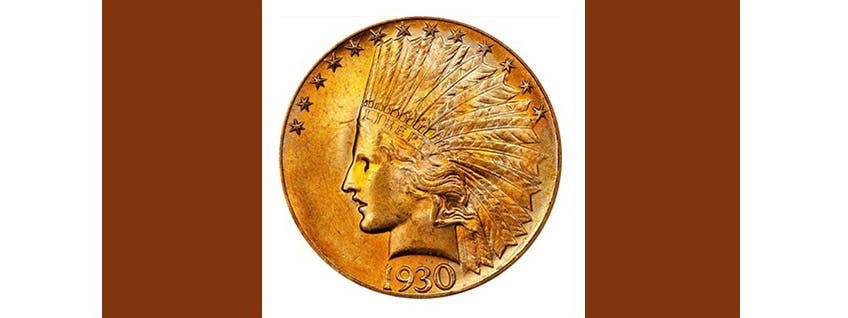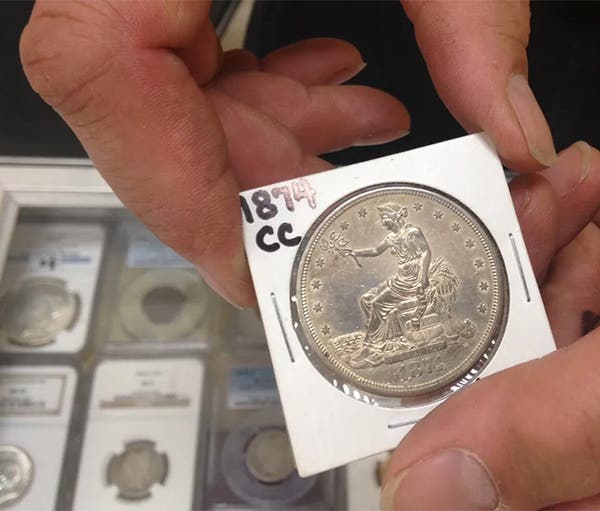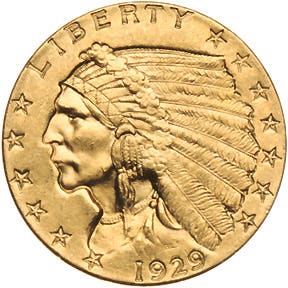Viewpoint: Pocket change still yields great finds
Many in our hobby are adamant that there is nothing good to find in circulation anymore. This is nonsense. There are many good finds in pocket change. What it takes is a focused approach and dedication. I’m not talking about going to your bank and buying a hundred dollars worth of rolled coins to pick through. Though, I do acknowledge such searches can be a wonderful way to add to your collection.
Many in our hobby are adamant that there is nothing good to find in circulation anymore. This is nonsense. There are many good finds in pocket change. What it takes is a focused approach and dedication. I’m not talking about going to your bank and buying a hundred dollars worth of rolled coins to pick through. Though, I do acknowledge such searches can be a wonderful way to add to your collection.
I’m talking about looking through coins obtained from actual circulation, pocket change. I’m talking about taking a dollar bill out of your wallet and purchasing something for 15 cents just to get three quarters and a dime back. I’m talking about buying the 99-cent bottle of soda with the 5-cent deposit, paying with two dollar bills and hoping that the clerk won’t simply reach to the penny cup, take four cents from there and give you one of the dollar bills back. I’m talking about peering into the change drawer of a cash register as it opens, and asking the cashier if you can have that shiny coin on the top of one of the compartments. I’m talking about scouring the return slots of coin phones and vending machines, even hunting around Coinstar machines to find some forgotten coins that may contain the key to your collection. I’m talking about true circulation finds.
In 1999, along with probably 20 million or so people, I started a collection of the 50 state quarters. Along the way I’ve started five more collections of this series. Each collection is strictly circulation finds. The condition of each collection, and the difficulty of finding suitable specimens for each collection, offers an interesting look at the availability of coins in the series. It offers insight into availability both at the time of first release of each of issue, and availability of each type over time.
I started in 1999 with a $3.95 Littleton coin folder, which calls for one example of each quarter, regardless of mintmark. I put the quarters in as each new issue came into my hands, usually within a couple of months of being issued. The coins in this folder are all in wonderful condition, as near “BU” as can be expected when pulling coins from circulation. This collection has toned beautifully over the years.
In the early years of the program coins were plentiful and easy to find within a short time of entering circulation. Still, I remember a few that were noticeably more difficult to find than others. Rhode Island took a while to locate, Mississippi was hard to find and Kentucky was never plentiful. When I did find Kentucky quarters the reverse never seemed to have a good, clean appearance, and Maryland coins seem to have come off the presses with built in scratches. Still, the collection was assembled. The second half of the program had more instances of issues that were difficult to find, but these presented no serious problems.
I thought it would be fun to start a second collection of the same series, and in late 2003 I purchased a second folder, identical to the first. I kept the folder empty until Jan. 1, 2004, and started in. Circulation finds only, and no help from coins already lying around that had been acquired prior to Jan. 1, 2004.
This second collection proved a bit more trying for the first 25 issues. Also with this second collection, I started noticing which coins were not struck as well as others, and which issues were not as generously distributed in New England. I don’t travel out of the area very often, and almost all of my circulation finds are coins that were originally distributed in the area when they were new, or were brought here by others.
The second collection confirmed that Rhode Island was not well distributed in New England, and when it was found, it usually had lots of scratches and marks in the reverse field. Mississippi was also rare here. Massachusetts, Georgia and Virginia, with astonishingly large mintages from Philadelphia, were not seen all that often. Connecticut, New York and Louisiana were as common as mosquitoes on a muggy July evening, though the New York and Louisiana coins were of relatively poor quality.
I started a third collection on Jan. 1, 2007, with the same expectations for condition. It was decidedly harder to find near mint state issues from circulation. A lot of these coins had been out working hard for the taxpayers for eight years. Still, persistence pays off. Connecticut was relatively easy to find in nice condition, maybe due to the “Charter Oak” covering most of the reverse. Delaware was difficult to find in nice condition, perhaps due to the lack of reverse field detail. Rhode Island specimens were routinely poor, Massachusetts coins were even poorer, New York and South Carolina were no better. The Maryland issue seems to be the worst of all. The Maryland coins are, almost without exception, “uncollectible.” The reverse of the Maryland coins always seem filled with the same scratches, rim nicks and discoloration found on some of the other issues, but the scratches and imperfections on the Maryland coins seem deeper, and more plentiful. On the other hand, Mississippi coins, when found, are often quite nice. Kentucky coins are scarce, and usually in poor condition.
During one of my trips out of the region, driving home on U.S. Route 202, I stopped at a Border’s in central New Jersey. On the clearance rack outside the front doors was a Whitman state quarters album. This is the “deluxe edition” including slots for both a “P” and “D” specimen of each coin. The clearance price was $2.49, including 2 percent of the total collection already given to you in the form of a “P” and “D” set of Minnesota quarters.
I struggled long and hard with my principles about whether to include these two coins in the collection. Eventually, I included them. Minnesota quarters were plentiful in New England, and the given coins were no better than anything I could have found in change. The official start date of this collection was June 1, 2008, and as of this date, it is still unfinished. I count the Whitman folder as two collections, as I have to collect 50 specimens from each of the two mints that produce quarters for general circulation purposes. Philadelphia issues fill more slots than Denver issues at this point.
I started my next collection on Jan. 1, 2010. All the issues have now been struck, and all the coins are in circulation. In 2011 it is a real challenge to fill the 50 holes in the Littleton album with high quality specimens. I can find examples of each of the 50 issues in circulation, but many examples are considerably worn. In 2011, many coins that were plentiful when first introduced are no longer found. When they first came out in 2007, the North Dakota coins were in tremendous quantity. I could have put away several BU rolls of the North Dakota quarter in the first two months of circulation. Now I haven’t seen a one for over a year. Similarly, the Wyoming coin was also seen in large quantities in 2007, but has almost disappeared from circulation here. The same can be said of the quarters for Iowa, Alabama, Washington and Texas. The Idaho coin is now plentiful, when in 2007 it was not seen often, and Oklahoma quarters have been consistently available right from their first appearance.
With vacant holes in the last three collections, I have made some rules for my collecting priorities. If I find a suitable specimen, it has to go in the vacant hole for the oldest collection. If I find a superb specimen I already have all the holes in all the folders filled for, I go back to the oldest collection and see if the new coin is better than what I already have.
One observation I have made is that coinage doesn’t travel much now. When I started collecting there was a decent assortment of “P,” “D” and “S” mintmarked circulation coins every time you checked your pocket. Now it is a rare to see a single D mintmarked coin here. Why is that?
My theory is that coins have taken on a strictly local circulation area. People don’t take pockets of change with them anymore when traveling. People receive coins in change, take them home, place them in a cup on their dresser and deposit them at a bank, or use them locally. When going out of the area, people take ATM cards. More and more people use electronic debit transponders to pay their tolls instead of cash.
Still, circulation finds are out there! You simply have to put your mind to the task of going out to search for them. The 50 states quarters will never be rare, but it is an interesting hunt to find them. Anyone can throw money at dealers or the Mint to get pristine examples of these delivered to their door. But how many collectors have the energy, patience and perseverance to assemble one or more BU, near BU, AU or XF sets of these coins from circulation finds?
I have chosen to focus on the 50 states quarters, but similar efforts can be made for any circulating issue. Try assembling a “one a year” XF or better collection of post 1964 dimes from circulation, or an XF collection of post 1982 cents. You will be undertaking years worth of gratifying collecting. These collections won’t be worth more than face value, but the side benefit is that you won’t die wondering if your heirs are going to be scammed by someone purchasing your collection. If my grandchildren take my collections apart and spend them at face value, they will get my full cost of the collection back, minus the cost of the albums that is.
I hear a lot of complaining about “overcharging by the Mint” and the “poor quality” of its products. I refuse to pay more than 25 cents for any coin, and when the next generation of collectors comes along in my family, I’ll be ready to show them that they can spend a little, but gain a great deal of satisfaction from collecting.
I intend to start a new state quarter collection every two years. Hopefully in 10 years or so I will be able to update Numismatic News on where the hunt has led me at that time.
James Evans is a hobbyist from Leominster, Mass. To have your opinion considered for Viewpoint, write to David C. Harper, Editor, Numismatic News, 700 E. State St., Iola, WI 54990. Send email to david.harper@fwmedia.com.
More Coin Collecting Resources:
• Subscribe to our Coin Price Guide, buy Coin Books & Coin Folders and join the NumisMaster VIP Program








